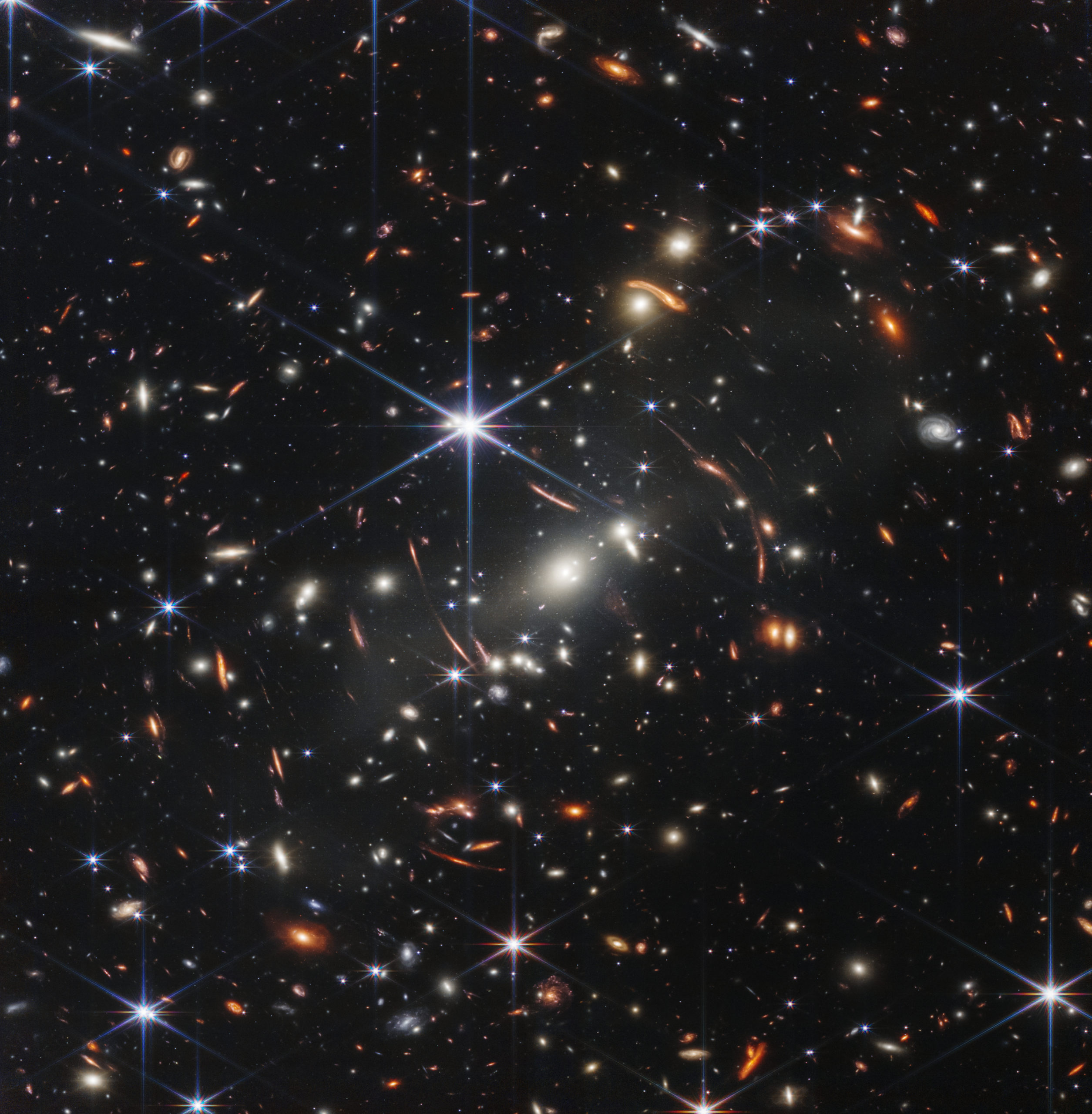Full resolution image (2799×2856) of the SMACS 0723 cluster of galaxies, 4.6 billion light years distant in the southern constellation Volans. Known as Webb’s First Deep Field, this image of galaxy cluster is overflowing with detail and is described more fully below. Images and results from Webb’s observations are archived here with the first images here.
The widely publicized event that kicked off full science operations for the James Webb Space Telescope spanned the globe. NASA, with the cooperation of its partners in the JWST program, the European Space Agency (ESA) and the Canadian Space Agency, unveiled the results of 5 separate studies, images and data with a high “wow” value.
Entitled “Celebrating Webb’s First Images“, the press and media event began with opening remarks at 9:45 AM, EDT and can be found here.
The list of targets presented and discussed were selected from the long list of targets imaged and/or studied during the commissioning process:
- Carina Nebula. The Carina Nebula is one of the largest and brightest nebulae in the sky, located approximately 7,600 light-years away in the southern constellation Carina. Nebulae are stellar nurseries where stars form. The Carina Nebula is home to many massive stars, several times larger than the Sun.
- WASP-96 b (spectrum). WASP-96 b is a giant planet outside our solar system, composed mainly of gas. The planet, located nearly 1,150 light-years from Earth, orbits its star every 3.4 days. It has about half the mass of Jupiter, and its discovery was announced in 2014.
- Southern Ring Nebula. The Southern Ring, or “Eight-Burst” nebula, is a planetary nebula – an expanding cloud of gas, surrounding a dying star. It is nearly half a light-year in diameter and is located approximately 2,000 light years away from Earth.
- Stephan’s Quintet: About 290 million light-years away, Stephan’s Quintet is located in the constellation Pegasus. It is notable for being the first compact galaxy group ever discovered in 1877. Four of the five galaxies within the quintet are locked in a cosmic dance of repeated close encounters.
- SMACS 0723: Massive foreground galaxy clusters magnify and distort the light of objects behind them, permitting a deep field view into both the extremely distant and intrinsically faint galaxy populations. (Note: the featured image for this article is the full resolution image of this galaxy cluster).
Of these, the last target image, SMACS 0723, was released last night during a scheduled “pre-event” at the White House. We will present and discuss that image here as the first in a series of 5 articles on each of these targets.
SMACS 0723
We’ll start this segment with a quote from NASA
Webb’s image is approximately the size of a grain of sand held at arm’s length, a tiny sliver of the vast universe. The combined mass of this galaxy cluster acts as a gravitational lens, magnifying more distant galaxies, including some seen when the universe was less than a billion years old. This deep field, taken by Webb’s Near-Infrared Camera (NIRCam), is a composite made from images at different wavelengths, totaling 12.5 hours – achieving depths at infrared wavelengths beyond the Hubble Space Telescope’s deepest fields, which took weeks. And this is only the beginning. Researchers will continue to use Webb to take longer exposures, revealing more of our vast universe.
Regarding this image, a question was posed during the Q & A:
Just wondering what this area looks like now, given that the light we see is billions of years old. Is everything still there?
This galaxy cluster is 4.6 billion light years distant, meaning this is how it looked 4.6 billion years ago. Not only are we looking across vast distances of space but we’re looking back in time, observing objects as they were, not as they are now. To see how it would be today, we’ll have to wait another 4.6 billion years, a point in time when the sun would have expanded to become a red giant star – and we would be long gone – to find a new home or not….
4.6 billion years ago the sun was just forming (the sun is 4.6 billion years old) with the earth and the rest of the planets following a hundred or so million years later. This is how the universe was when the sun formed, so we get to observe and measure that environment, remarkable in that this may give us new insights into our own beginnings – at the precise time in cosmic history when our home star and solar system were just forming.
The Hubble Metric
In 1929, Edwin Hubble (with the work of Henrietta Swan Leavitt and others) published the Hubble metric, the relationship between an object’s distance and its recessional (radial) velocity. Hubble’s original result was much higher than today’s accepted value of ~74 km/s/mpc (kilometers per second per mega-parsec). This galaxy cluster has a redshift of 0.36 (the ratio of the change in wavelength to the rest wavelength of the observed light). We can use this value (0.36) to calculate the actual recessional velocity and, doing so yields a value of 0.30c or 30% the speed of light! In the intervening 4.6 billion years since the light we see today left those galaxies, the cluster has traveled (4.6*0.30) = 1.38 billion light years further.
So, to address the original question, the cluster is 6 billion light years distant today and would probably appear distinctly redder. Many young, high-mass stars 4.6 billion years ago would have ended their lives long ago as supernovae, any sun-like stars would have evolved and expanded to become red giant stars or planetary nebulae. The remaining population of stars would be red dwarfs and cooler, evolved stars.
Elliptical Galaxies

Messier 87, a massive elliptical galaxy in the constellation Virgo. Close inspection of the galaxy reveals the swarm of globular star clusters surrounding the galaxy, the same type of clusters that surround the central galaxy in the SMACS 0723 cluster. Image: NASA/ESA Hubble Space Telescope.
This cluster consists mostly of elliptical galaxies with a massive elliptical galaxy at the center. Elliptical galaxies can be identified by their shape, decidedly warm glow (the integrated light from all the old, evolved stars) and the lack of any gas, dust or spiral arms.
They contain some of the oldest stars in the universe, evolved stars with no gas or dust remaining in the galaxy. Gas and dust is the raw material for new star formation and thus, no new stars are forming in these galaxies. The massive central galaxy would appear slightly fainter and somewhat redder. These ancient stars (red dwarfs and k-class stars) are just running out their clocks, eventually fading out as the eons go by. If you look closely at this central galaxy, you will see hundreds (maybe thousands) of globular star clusters surrounding it, each with 100s of thousands or millions of stars each. It’s safe to say this galaxy contains some of the oldest stars in the universe.
It is also interesting to note how “bright” this central galaxy is given this is a Near Infrared image. NirCam images the universe in the near infrared, starting at 600 nanometers (visible, red light). That this galaxy appears bright in this wavelength regime is evidence of its stellar population as described above, a composition consistent with elliptical galaxies such as M-87 in Virgo.
Gravitational Lensing
As stated above, the central galaxy is a massive elliptical galaxy. An aspect of this image consistent with the high mass of the central galaxy and the total mass of the cluster is the strong gravitational lensing. Note the distorted images of the more distant cluster of galaxies. These are the galaxies referenced in the NASA quote above with the faintest members dating back to a time when the universe was less than a billion years old; in other words, they’re over 13 billion light years distant!
According to General Relativity, any object will cause a distortion in the fabric of space and thus, the more massive the object, the greater the distortion. Gravitational lensing occurs when a massive object (such as SMACS 0723) lies between an observer and a more distant object or group of objects. The light from the more distant objects is constrained to follow the fabric of space and is thus distorted as it travels along the distorted space in the vicinity of the intermediate mass.
Attribution
”The Early Release Observations and associated materials were developed, executed, and compiled by the ERO production team: Hannah Braun, Claire Blome, Matthew Brown, Margaret Carruthers, Dan Coe, Joseph DePasquale, Nestor Espinoza, Macarena Garcia Marin, Karl Gordon, Alaina Henry, Leah Hustak, Andi James, Ann Jenkins, Anton Koekemoer, Stephanie LaMassa, David Law, Alexandra Lockwood, Amaya Moro-Martin, Susan Mullally, Alyssa Pagan, Dani Player, Klaus Pontoppidan, Charles Proffitt, Christine Pulliam, Leah Ramsay, Swara Ravindranath, Neill Reid, Massimo Robberto, Elena Sabbi, Leonardo Ubeda. The EROs were also made possible by the foundational efforts and support from the JWST instruments, STScI planning and scheduling, and Data Management teams.”
Astronomy For Change: https://astronomyforchange.org
Buy us a Coffee? https://www.buymeacoffee.com/astronomychange
Follow Us On Twitter: https://twitter.com/astronomychange
Why not support us on Patreon: https://www.patreon.com/astronomyforchange
Imagination is more important than knowledge
![]()
An index of all articles can be found here.
If you enjoyed this article, please consider supporting us with a modest donation
or through a subscription on our Patreon Page
Membership at Astronomy for Change is Free!




